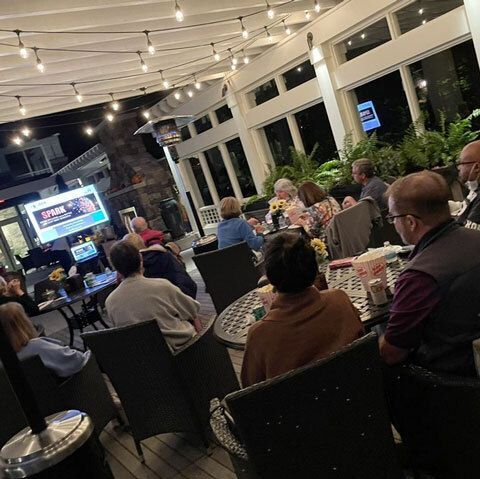
Lewy Body Dementia: Your Questions Answered!
In honor of Lewy Body Dementia Awareness month, Insight Memory Care Center, The Kensington Falls Church and The Kensington Reston held a special screening of the film SPARK. We learned more about Lewy Body Dementia through Robin William’s journey and afterwards had a great panel discussion with the Lewy Body Dementia Association. Here are your questions with their answers!
If someone has hallucinations re: people/ animals and other mental issues are ruled out, is it likely they have LBD vs some other cognitive issue?
Hallucinations (just like any symptom of LBD) is that – a symptom. Thus, it is still important for the involved physicians to piece together as much as possible about this specific symptom, additional symptoms, screening results, evaluations, etc. to gain the more complete picture and provide as much clinical feedback on the “why” behind the symptoms seen. Here’s more information on the diagnostic process of LBD - LBDA Diagnosis and Assessment - https://www.lbda.org/lbd-diagnosis-assessment/
Sounds like diagnosing the types of LBD is difficult- does it matter? How does this affect treatment or prognosis?
Yes, it can be a difficult process – however, many individuals and their families find true benefit in clarifying the diagnosis as this can provide additional reasons to why symptoms may be presenting, seek diagnosis specific treatment and interventions, and find community with others who share the diagnosis (or are supporting someone with the diagnosis). Yes, treatments and techniques can vary specific to the diagnosis.
Do individual personality traits affect the behavior of people with LBD or is it solely neurological?
I personally think it is a mix of both prior traits and neurological changes that can occur. The diagnosis can be received, supported, and experienced in different situations and circumstances. However, prior frustrations, joys, annoyances, and engagements often continue to be preferences – even following the neurological changes.
Recommendations for non-medical approaches? Are certain therapies or interventions helpful?
Many times what may be helpful can be from a variety of sources to continue to meet the physical, psychological, social, spiritual, and professional (if appropriate) needs of the individual who is diagnosed and their care partners. Often we focus on the medical – which is important – but, this diagnosis affects a whole person and their support systems, not just their brain. It’s important to first receive feedback from the person who is symptomatic/diagnosed on their own priorities and then it is often a mix of creative brainstorming and professional guidance and advice on how to maintain priorities and safety while meeting needs. Social work, counseling, and various mental health professionals and approaches can be helpful. Exercise, social engagement and participation in various activities that are meaningful to the individual supports quality of life for both the individual with LBD and the care partner.
Physical therapy, occupational therapy, speech therapy, and swallow evaluations are likely beneficial to help with mobility, address fall risk and teach fall prevention strategies and aids, identifying helpful resources to assist function (e.g. shower bars, commodes, and bed rails), and address swallowing difficulties. Due to the complex nature of the condition, it can be helpful to have a variety of specialists, medical and non-medical to assist with symptom management and quality of life. It is important to make sure that all members of your “team” are aware of your varying treatments for safety and continuity of care.
Pathways to Well-Being with Dementia from Dementia Action Alliance is a great resource for this question. Manual About Living With Dementia | Dementia Action Alliance (daanow.org)
How do peer groups work with people who have LBD and can’t hold a conversation? Are there a good portion of peer groups available?
Peer support can be incredibly helpful – both one-on-one and in the group setting. There are a variety of options available and you can learn more about what may support your specific needs through connecting with the LBDA support team through our Lewy Line at 800-539-9767 or through emailing support at support@LBDA.org.
How do you know that more or different diagnosis is warranted?
It is always okay to ask for a second opinion, or to ask questions of your diagnosing provider. You can try using our diagnostic symptom checklist to see if you feel a discussion is warranted with your provider and explain why you are questioning the possibility of a diagnosis of LBD. This will also allow your provider to explain the reasons why they have given the diagnosis they provided.
Diagnostic LBD Symptom Checklist - https://www.lbda.org/wp-content/uploads/2017/09/2017_diagnostic_checklist_-_updated_criteria_v2_1.pdf
Is LBD hereditary? Is there any marker or screening test known or available?
“When dementia with Lewy bodies is caused by SNCA or SNCB gene mutations, it is inherited in an autosomal dominant pattern, which means one copy of the altered gene in each cell is sufficient to cause the disorder. In these cases, an affected person usually has one parent with the condition.
People with a mutation in one copy of the GBA gene or one copy of the APOE e4 allele inherit an increased risk of developing dementia with Lewy bodies, not the condition itself. Some people with these genetic variants never develop dementia with Lewy bodies. This increased risk is inherited in an autosomal dominant pattern.”
Source: https://medlineplus.gov/genetics/condition/dementia-with-lewy-bodies/#inheritance
Testing for α-synuclein aggregates in the cerebrospinal fluid (CSF) and/or via skin biopsy is now available through some commercial laboratories, but these tests are not yet widely available for use in clinical settings.
Describe please the typical progression and timeline of the disease.
“No staging system for LBD currently exists…..experiences, however, are diverse, with both rapid and slowly progressive LBD forms. In one study, over 10% of individuals with LBD died less than 1 year after diagnosis, while another 10% lived more than 7 years after diagnosis, and a small percent lived more than 10 years after diagnosis.”
Armstrong M. J. (2021). Advances in dementia with Lewy bodies. Therapeutic advances in neurological disorders, 14, 17562864211057666. https://doi.org/10.1177/17562864211057666
Can someone have Alzheimer’s and LBD at the same time? Which one is usually diagnosed first?
It is estimated that half of all individuals with Lewy body disease have sufficient pathology for a secondary diagnosis of Alzheimer’s Disease at autopsy. Different distributions of α-synuclein and tau pathology associate with the phenotypic expression of LBD. When the distribution of α-synuclein pathology is greater than tau pathology, a clinical diagnosis of LBD is highly likely. A clinical DLB diagnosis is less likely when the distribution of tau pathology is greater than α-synuclein, with some caveats. The distribution of α-synuclein, tau, and amyloid pathology also contributes to disease duration in DLB.
Armstrong M. J. (2021). Advances in dementia with Lewy bodies. Therapeutic advances in neurological disorders, 14, 17562864211057666. https://doi.org/10.1177/17562864211057666
If Robin Williams had such a severe case of LBD, how is it that nothing showed up in the tests? As his wife said it wasn’t diagnosed until after death.
Diagnosis relies largely on a comprehensive history and physical examination assessing core and supportive features of LBD. Neuropsychological testing and structural imaging (typically MRI) are part of many standard evaluations for dementia. Other tests and biomarkers, however, are uncommonly used by specialists making DLB diagnoses. Polysomnography is occasionally used by specialists to assess for REM sleep particularly if the presence of RBD is uncertain by history. Similarly, dopamine transporter (DAT) imaging is occasionally used to strengthen suspicion of a LBD diagnosis if there is no or equivocal parkinsonism on examination. Low uptake on metaiodobenzylguanidine (MIBG) myocardial scintigraphy is an indicative biomarker in the LBD criteria, but this test is not available in many countries (including the United States) for this purpose.
Testing for α-synuclein aggregates in the cerebrospinal fluid (CSF) and/or via skin biopsy is now available through some commercial laboratories, but the role that these tests play in routine clinical diagnosis is yet to be established and was not available for diagnosis in 2012.
Armstrong M. J. (2021). Advances in dementia with Lewy bodies. Therapeutic advances in neurological disorders, 14, 17562864211057666. https://doi.org/10.1177/17562864211057666
Why did Robin Williams hold his left arm to his side as the disease progressed?
Rigidity is one of the motor features of LBD, causing stiffness in the joints. Often the shoulder joint and elbow (and wrist) become stiff, typically more on one side of the body, but can be on both sides of the body with progression of the motor symptoms. People with Parkinson’s disease and LBD will often hold the arm, place the hand in a pocket or support the arm due to the stiffness. This will sometimes be present to attempt to hide a tremor in the hand as well.
Many thanks to the Lewy Body Dementia Association for facilitating this fantastic discussion! For more information, visit the Lewy Body Dementia Association at LBDA.org.
Blog
"I like that IMCC focuses on dementia-related problems and provides a focal point for families to network and socially interact in coping with dementia. It provides a community that helps us in our struggle."




